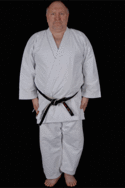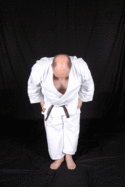 Rei - Bow
Rei - Bow
Yoi - Ready position
Yasume - Return to Yoi
Naore - Relax
Enbusen - The invisible performance line on which the kata is performed.
Kiai - Focus point in the kata where the Karate-Ka shouts.
Kata
Karate kata are sequences of basic, intermediate and advanced techniques arranged into set orders and patterns. The closest examples or equivalents of the Karate kata in other activities or sports are shadow boxing, dance routines and the floor routines in gymnastics. The name kata is a Japanese term translated as mold, model, style, form or shape.
Each kata has it’s own character. Some kata are heavy and powerful whereas others are far more graceful and flowing in their nature. Many kata however, contain a mixture of both and each one has it’s own unique timing. The 26 shotokan kata are all individually named with differing intricacies. In some cases, the source of the name is obvious. In others, the name of the kata can only be guessed at from the kanji that their identity was originally written in.
Heian Kata
On the island of Okinawa, this group of kata were originally called the 'Pinan’ kata. The name Heian was given to them by Sensei Gichin Funokoshi and is most commonly interpreted as meaning 'Peaceful Mind’. The Heian kata are named in a fashion that indicates their level of difficulty, i.e. one to five. With the exception of the Tekki kata, the other Shotokan kata are not named using such a numerical system.
Tekki Kata
This group of three kata were originally called the Naihanchi kata. Once again this name was replaced by Funokoshi Sensei and changed to Tekki. The name Tekki is taken from the character 'Tetsu’ meaning iron or steel and 'Ki’ meaning to ride a horse or simply knight. One possible translation of the name Tekki is 'Iron Knight’.
Dai and Sho Kata
The Japanese kanji (characters) for Dai and Sho simply translate as 'Big’ and 'Small’. Despite a common misconception, Dai kata are not anymore or any less advanced than their Sho versions. Despite the translation of big and small, the Gojushiho kata are reversed. The 'dai’ version of these two kata is actually smaller than that of 'Sho’.
NOTE:
The names of both Gojushiho kata within Master Kanazawa's SKI group have been reversed, i.e. Gojushiho Sho is known as Gojushiho Dai, due to the nature of the kata being considered by Master Kanazawa as smaller.
 Rei - Bow
Rei - Bow
 Rei - Bow
Rei - Bow